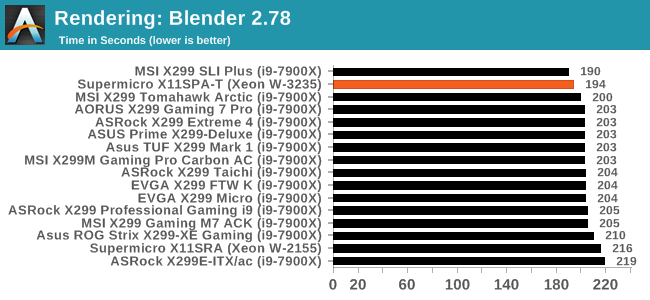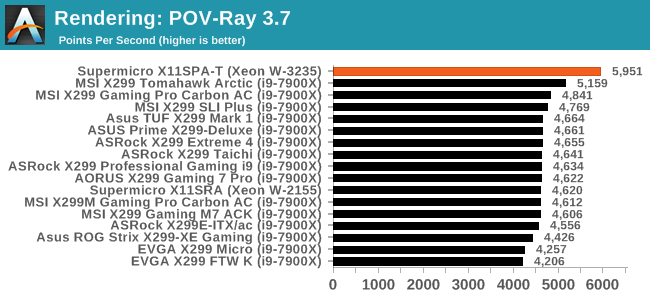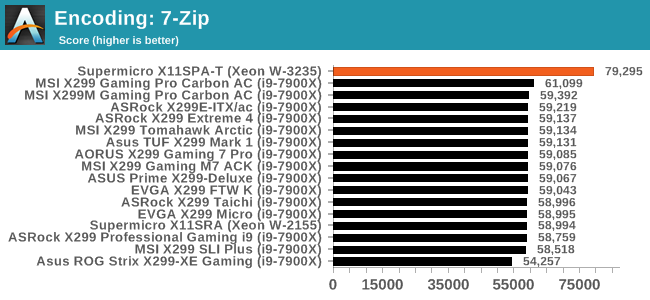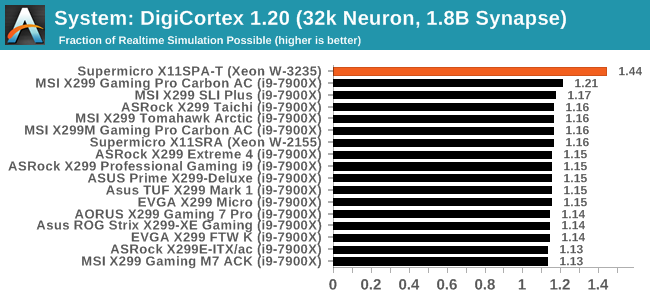The Supermicro X11SPA-T Review: An Impressive Cascade Lake Workstation Motherboard
by Gavin Bonshor on January 24, 2020 9:00 AM ESTCPU Performance, Short Form
For our motherboard reviews, we use our short form testing method. These tests usually focus on if a motherboard is using MultiCore Turbo (the feature used to have maximum turbo on at all times, giving a frequency advantage), or if there are slight gains to be had from tweaking the firmware. We put the memory settings at the CPU manufacturers suggested frequency, making it very easy to see which motherboards have MCT enabled by default.
*Note, the W-3235 we were supplied to test the system with is a 12-core chip, while the other CPUs tested against in previous X299 reviews used a 10-core CPU. So some results are obvious, this is more a tick box to check that there's nothing out of the ordinary.
Rendering - Blender 2.78: link
For a render that has been around for what seems like ages, Blender is still a highly popular tool. We managed to wrap up a standard workload into the February 5 nightly build of Blender and measure the time it takes to render the first frame of the scene. Being one of the bigger open source tools out there, it means both AMD and Intel work actively to help improve the codebase, for better or for worse on their own/each other's microarchitecture.

Rendering – POV-Ray 3.7: link
The Persistence of Vision Ray Tracer, or POV-Ray, is a freeware package for as the name suggests, ray tracing. It is a pure renderer, rather than modeling software, but the latest beta version contains a handy benchmark for stressing all processing threads on a platform. We have been using this test in motherboard reviews to test memory stability at various CPU speeds to good effect – if it passes the test, the IMC in the CPU is stable for a given CPU speed. As a CPU test, it runs for approximately 1-2 minutes on high-end platforms.

Compression – WinRAR 5.4: link
Our WinRAR test from 2013 is updated to the latest version of WinRAR at the start of 2014. We compress a set of 2867 files across 320 folders totaling 1.52 GB in size – 95% of these files are small typical website files, and the rest (90% of the size) are small 30-second 720p videos.

Synthetic – 7-Zip 9.2: link
As an open source compression tool, 7-Zip is a popular tool for making sets of files easier to handle and transfer. The software offers up its own benchmark, to which we report the result.

Point Calculations – 3D Movement Algorithm Test: link
3DPM is a self-penned benchmark, taking basic 3D movement algorithms used in Brownian Motion simulations and testing them for speed. High floating point performance, MHz, and IPC win in the single thread version, whereas the multithread version has to handle the threads and loves more cores. For a brief explanation of the platform agnostic coding behind this benchmark, see my forum post here.

Neuron Simulation - DigiCortex v1.20: link
The newest benchmark in our suite is DigiCortex, a simulation of biologically plausible neural network circuits, and simulates activity of neurons and synapses. DigiCortex relies heavily on a mix of DRAM speed and computational throughput, indicating that systems which apply memory profiles properly should benefit and those that play fast and loose with overclocking settings might get some extra speed up. Results are taken during the steady-state period in a 32k neuron simulation and represented as a function of the ability to simulate in real time (1.000x equals real-time).











31 Comments
View All Comments
Pneumothorax - Friday, January 24, 2020 - link
I'm sure the profit margin on these is quite a bit less then ridiculously overpriced Z390 & X570 boards named after some deity...Operandi - Friday, January 24, 2020 - link
True for some of them for sure but a lot of the consumer boards that are aimed at the high-end overclocking are the real deal in terms of engineering. Very powerful and efficient VRMs are not cheap and a lot more overbuilt than on something like in this board so the margins are probably not as crazy high as you think (at least in the middle of the Z390 X570 market).airdrifting - Sunday, January 26, 2020 - link
What overclocking are you talking about? Overclocking a 9900K from 4.7GHz stock all core turbo to 5.0GHz and look at 95C loaded temperature, or overclocking Ryzen 0.1GHz past the precision boost? You kids don't know anything about overclocking nowadays.Ironchef3500 - Monday, January 27, 2020 - link
+1brucethemoose - Monday, January 27, 2020 - link
+1There is *a little* headroom in HEDT CPUs, for now...
web2dot0 - Tuesday, February 11, 2020 - link
Still remember those Celeron 300A days OC to 450MhzThe glory days of Overclocking ...
Operandi - Friday, January 24, 2020 - link
I will say the marketing sucks though. I don't give a fuck about an Aorus regardless of how extreme it may be and I really don't want to join a republic, thanks for asking though.GreenReaper - Sunday, January 26, 2020 - link
They're not exactly *asking* - the red-cloaked tide of Gamers have annexed several nearby states. For a while it looked like they'd take the Ministry of Sound, but fortunately Realtek pushed them back.Operandi - Friday, January 24, 2020 - link
Also, these comments are in reverse order cause there isn't a edit button. Oh well.....rahvin - Friday, January 24, 2020 - link
The 570 boards are expensive because they are the first PCIE4 motherboards. That and they needed a 12 layer board to get the pcie trace lengths within the spec limits. As the OEM's get more experience with 4.0 they'll drop in price but the first boards are always going be $$$ because of the additional engineering. You might not remember but the first 3.0 boards were more expensive too.